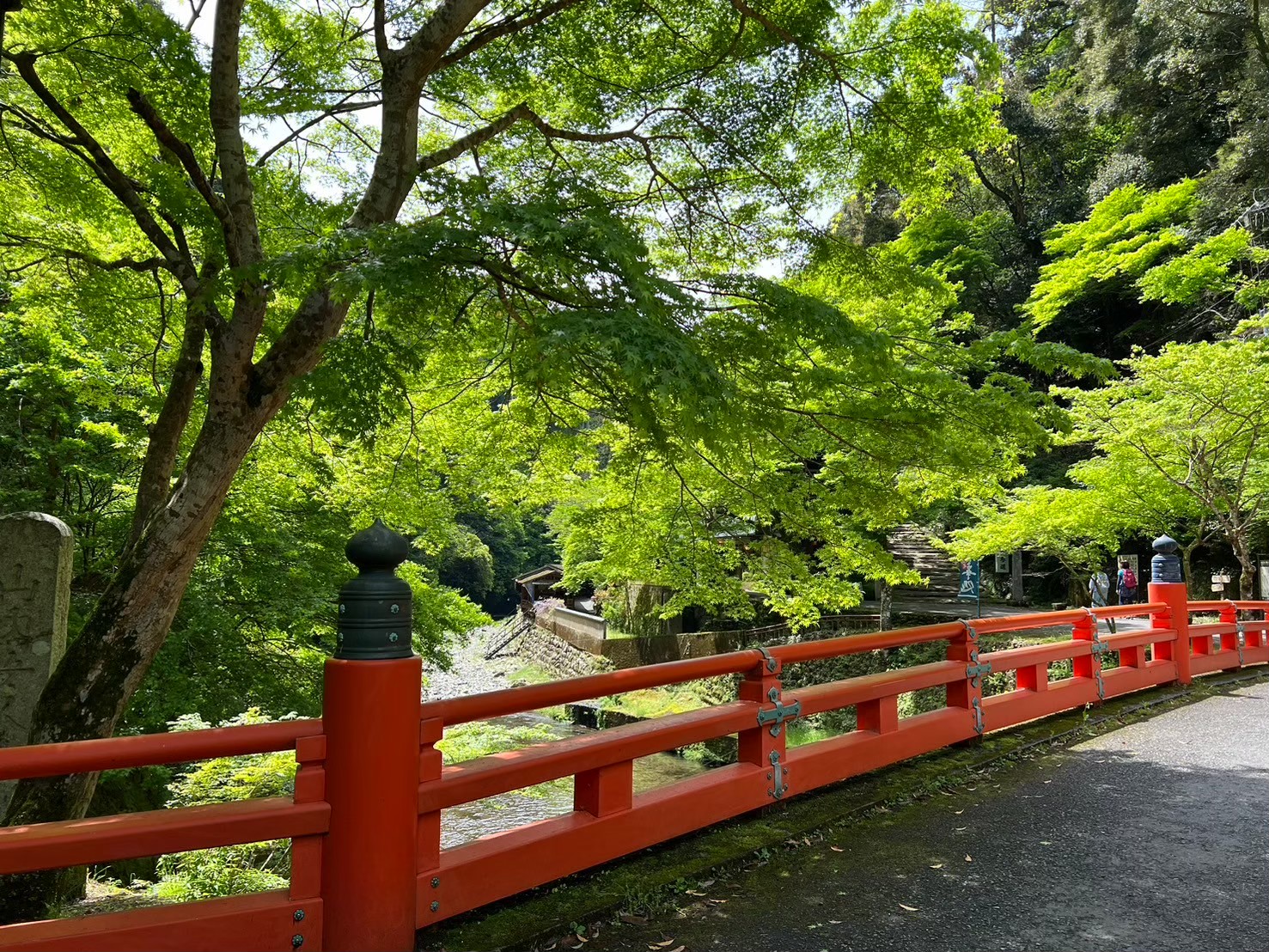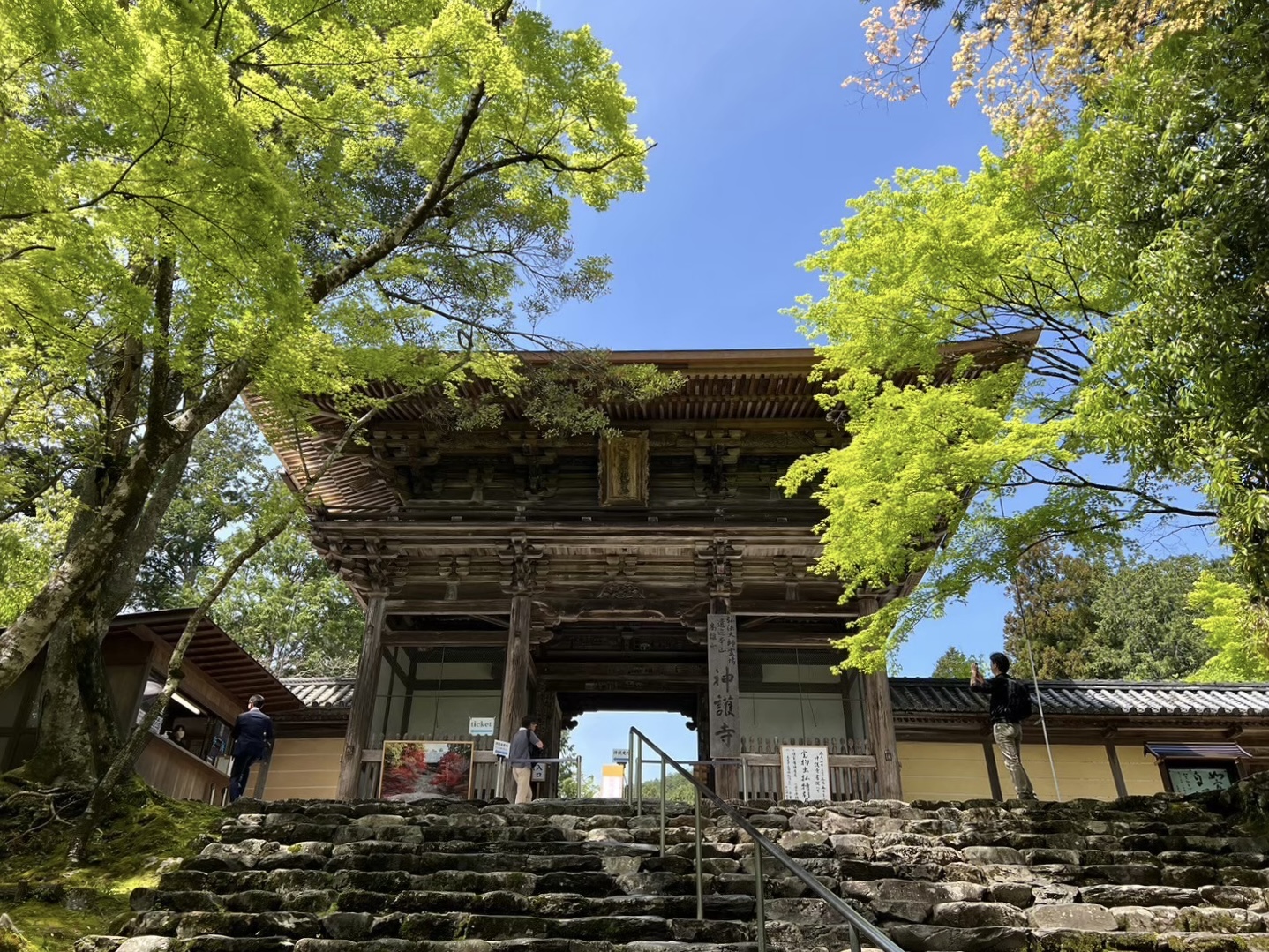Jingo-ji Temple is a private temple of the Wake family, who were known for protecting the Imperial family during the great scandal of the Nara period, the Usa Hachiman Oracle Incident. The temple also became a significant center for the dissemination of esoteric Buddhism, deeply associated with the two great Buddhist masters, Kūkai and Saichō. During the relocation of the capital to Heian-kyō, Emperor Kanmu strictly limited the relocation of large temples from Nara to the new capital, so there are not many temples in Kyoto that were established during the Nara period. Among those, Tō-ji, located at the entrance of Heian-kyō and serving as a vital point for the protection of the capital, and Jingo-ji, which became a key training ground for esoteric Buddhism, hold a special status.
Access
From central Kyoto, you can reach Jingo-ji Temple by transferring between the subway and a bus. The journey takes about an hour. On weekdays, the bus tends to be quite crowded with students until the Ritsumeikan University stop, but it becomes much emptier afterward. To reach Jingo-ji, get off at the “Takao” stop and follow the signs as you descend the stone steps. If you visit during the season of fresh greenery, you’ll be welcomed by the vibrant green maple trees and a cool breeze passing over the river. I visited during this season, and the numerous maple trees made me think that the autumn foliage must be incredibly beautiful. After crossing the red bridge and passing by riverside restaurants, the path to the main hall involves a significant climb up stone steps. This ascent reminds you that this place is a site of ascetic training, but the surrounding fresh greenery or autumn colors will encourage you as you make your way up.

Temple Ground
After climbing the stone steps and passing through the mountain gate, you’ll find a surprisingly flat and open temple grounds, which is unusual for a mountaintop location. Before heading to the main hall (Kondō), there is also the entrance to the path leading to the grave of Wake no Kiyomaro. Just when you think the climb is finally over, another set of stone steps awaits you on the way to the Kondō, where the National Treasure Yakushi Nyorai (Medicine Buddha) is enshrined. As you look up at the roof of the Kondō from the bottom of the steps, you can reflect on the long history of this temple, which survived major fires in the 10th and 12th centuries, as well as periods of great glory and decline. The current Kondō was rebuilt in 1934 (Showa 9) through the donation of Yamaguchi Gendō, and it serves as an authentic esoteric Buddhist hall with a tiled roof.

The path leading to the grave of Wake no Kiyomaro is a beautiful moss-covered trail surrounded by Kitayama cedars and maple trees. In the dappled sunlight, it takes about 10 minutes to reach the grave after starting the ascent from the entrance. Although the fence and other structures were damaged by a recent typhoon, it is said that Wake no Kiyomaro appeared in the dream of one of his descendants, instructing them to “repair the grave.” As a result, thanks to a donation from this descendant, the grave was restored in 2023 and is now well-maintained. The power of dreams is truly amazing!
History
At the beginning, I mentioned that Jingo-ji was a private temple of the Wake family, whose member, Wake no Kiyomaro, saved the Imperial family. Kiyomaro was a nobleman who played a crucial role from the end of the Nara period to the early Heian period. During the reign of Empress Shōtoku, the last emperor from the line of Emperor Tenmu, a monk named Dōkyō, taking advantage of the empress’s favor, conspired with the head priest of Usa Hachiman Shrine to issue a false oracle, almost resulting in Dōkyō becoming emperor. However, Kiyomaro thwarted this plan. As a result, he incurred the wrath of both Dōkyō and Empress Shōtoku, had his name changed to “Kitanamaro” (meaning “dirty Maro”), and was exiled. Dōkyō even tried to have him killed afterward, but Kiyomaro managed to survive. After the death of Empress Shōtoku and the downfall of Dōkyō, Kiyomaro was favored by Emperors Kōnin and Kanmu, who were from the line of Emperor Tenchi, and he rose to great prominence.
His eldest son, Hiroyo, as a protector of Buddhism, invited Saichō, who had just returned from Tang China, to Takao-zanji Temple (later known as Jingo-ji) to conduct Buddhist ceremonies. Later, Kūkai was also invited to reside there, where he performed esoteric Buddhist rites. Thus, Jingo-ji grew beyond just a private temple of the Wake family, becoming a central training ground for esoteric Buddhism in the Heian period.
After Kūkai’s time, the temple suffered two major fires (in 994 and 1149) and went into decline by the late Heian period.
In the late Heian period, a monk named Mongaku lamented the deterioration of Jingo-ji and petitioned Emperor Go-Shirakawa for donations to restore the temple. However, Mongaku’s persistent demands displeased the emperor, leading to his exile to Izu. In an interesting twist of fate, Mongaku met Minamoto no Yoritomo in Izu and urged him to overthrow the Taira clan. It seems that Mongaku played a behind-the-scenes role, like a fixer, in connecting Yoritomo and the emperor for the eventual defeat of the Taira. Following this, Mongaku secured support from both Yoritomo and the emperor for the restoration of Jingo-ji. After Mongaku, his disciples, including Jōkaku and Myōe, continued his mission, but Jingo-ji would continue to be buffeted by the waves of history.
Treasures
Due to its rich history and significance, Jingo-ji Temple houses a great number of temple treasures, including many National Treasures and Important Cultural Properties. Once a year, in early May, a special event called “Mushibarai” (insect repelling) is held for three days. If you are fortunate enough to visit during this period, you can see many of these precious treasures firsthand, which you might otherwise only know from photographs or catalogs.

Principal Image: Standing Statue of Yakushi Nyorai (National Treasure, estimated to be from the early Heian period?)
This Buddha statue, carved from a single piece of robust kaya wood, including its base, has a solid and substantial form. Its expression is rather stern, evoking a sense of awe in those who gaze upon it. Long ago, Kūkai likely also revered this statue. It is believed that this Buddha may have been the principal image of either Jinganj-ji, the predecessor of Jingo-ji, or Takao-zanji. When I first worshipped this statue at Jingo-ji, I was overwhelmed and captivated by its immense dignity, and I wanted to keep gazing at it. Two months later, I had the long-awaited opportunity to see it again at the Jingo-ji exhibition at the Tokyo National Museum. However, it did not convey the same sense of majesty and power as when I saw it at Jingo-ji. In fact, it felt noticeably smaller than when I had seen it in the temple. Perhaps this was due to the way it was displayed. This experience strongly reaffirmed my belief that the principal image should be venerated in its rightful place. It is truly a magnificent Buddha, so I highly encourage everyone to visit Jingo-ji.
Takao Mandala (National Treasure, estimated 9th century, early Heian period)
This mandala, considered the oldest and highest masterpiece of esoteric Buddhist paintings in Japan, was created around the time Kūkai established the initiation hall at Jingo-ji Temple, fulfilling the wish of Emperor Junna. The dual mandalas, painted on crimson silk with gold and silver pigments, have suffered significant damage and have undergone two major restorations in the past. The third restoration in history was completed in 2021, and the mandalas were publicly displayed for the first time at the exhibition commemorating the 1250th anniversary of Kūkai’s birth at the Nara National Museum. The mandala is so intricate and detailed that even a close inspection cannot capture all its intricacies. One can only imagine the immense time and effort invested in creating it. The sheer size of the mandala is also overwhelming. During the exhibitions at the Nara and Tokyo National Museums, the preliminary drawings of each Buddha depicted in the mandala were also displayed, and they were truly breathtakingly beautiful and sacred.
★ In 2024, to commemorate the 1250th anniversary of Kūkai’s birth, the Takao Mandala was exhibited in the following exhibitions:
- Special Exhibition for the 1250th Anniversary of Kūkai’s Birth: “Kūkai” at the Nara National Museum
- Special Exhibition for the 1200th Anniversary of Jingo-ji Temple: “Jingo-ji” at the Tokyo National Museum
Jingo-ji Temple also houses many other National Treasures:
- The three famous portraits known as the Jingo-ji Sanzō (Three Images of Jingo-ji): the Portrait of Minamoto no Yoritomo, the Portrait of Taira no Shigemori, and the Portrait of Fujiwara no Mitsuyoshi (National Treasures, 12th century).
- The Silk Painting of Shakyamuni Buddha (National Treasure, late Heian period).
Kawarake-nage (Clay disc throwing)
From the garden of Jizō-in, located at the western edge of the Jingo-ji temple grounds, visitors can participate in kawarake-nage by throwing small clay discs down into the Kiyosegawa River gorge far below. For many, the hidden highlight of a visit to Jingo-ji is making a wish for warding off evil by tossing these discs toward the breathtaking view below. The singer Masashi Sada is a big fan of Jingo-ji and has mentioned that after his tours, he often visits the temple with his staff, always making sure to perform kawarake-nage during his visits.

